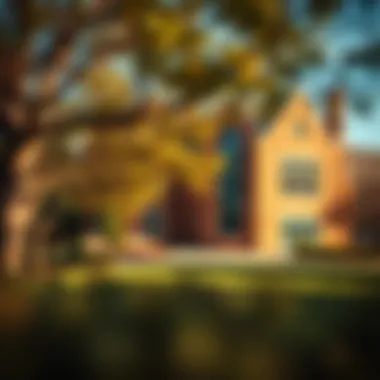Exploring the Landscape of Private Schools


Intro
When considering the world of education, the landscape of private schools emerges as a compelling chapter, teeming with intricacies that partner well with student aspirations and family expectations. Private schools often attract attention for their historical significance and the diverse philosophies they offer, creating a rich tapestry that can influence community values and educational outcomes.
To understand the role that private schooling plays in today’s society, it is informative to analyze recent market trends and property investment strategies. Both these elements don't merely highlight the existence of private schools but offer insight into their operation, success, and the implications for families and communities.
As we delve deeper, the complexities of funding, curriculum choices and the broader implications of accessing private education will also come into focus. Families are often faced with choices fueled by various factors such as academic quality, extracurricular opportunities, and the overall school environment. This exploration will provide clarity and foster meaningful dialogue around the impact of private schools in shaping educational pathways.
Market Trends and Analysis
Current Market Conditions
Private schools appear to stand strong amidst educational shifts. Reports suggest a steady growth in enrollment numbers, even as public schools face challenges in adapting to an evolving educational landscape. This surge reflects families’ desire for smaller classroom sizes, specialized curriculums, and opportunities for individualized attention.
Factors contributing to these market conditions include rising economic incentives, competition for quality education, and the perception of safety and community within private institutions. Additionally, wealthy neighborhoods often correlate with the growth of private school networks, signifying lasting ties between real estate markets and educational choices.
"Enrollment in private schools is not just a trend; it's indicative of a larger societal shift toward tailored educational experiences."
Future Predictions and Growth Areas
Looking ahead, several areas emerge as ripe for growth. Innovation in educational practices, such as project-based and remote learning, could see private institutions evolve dramatically, attracting a broader demographic of students. Moreover, many families are prioritizing values-based education, leading to an increased demand for institutions that align with personal beliefs, whether it be religious, cultural, or philosophical.
Online platforms and technology integration will be pivotal in this shift. Schools that adapt to engage students virtually while maintaining a strong physical presence may find themselves ahead of the curve. Growth is likely to be seen in holistic programs as well, emphasizing not just academic prowess but also emotional intelligence and personal development.
Property Investment Strategies
In parallel to the rising interest in private education, real estate investments tied to these institutions can offer unique advantages. Understanding where families choose to buy homes based on proximity to reputable private schools can provide insights into emerging market opportunities.
Types of Properties to Consider
Investors might focus on:
- Single-family homes that offer enough space for growing families.
- Townhouses or condominiums in areas known for outstanding private institutions.
- Multi-family properties which can be attractive to families seeking rental income while residing close to reputable schools.
Considering properties in growing neighborhoods with strong private school systems can yield long-term investment benefits.
Financing Options and Considerations
Navigating the financing of properties linked to private school access requires strategic thinking. Common options include:
- Traditional mortgages that suit detailed budgets.
- Investment loans for multi-family units anticipated to generate rental income.
- Federal Housing Administration loans, which are sometimes overlooked, but can provide low down payment options.
Engagement with local real estate professionals who understand both educational landscapes and market dynamics is essential. Doing this not only aids in choosing the right property but also enhances the investment strategy, aligning it seamlessly with family needs and community demand.
Preface to Private Schools
Private schools represent a vital component of the educational landscape, offering distinct alternatives to public education. For many families, these institutions provide tailored educational experiences that align closely with their values and aspirations for their children. Understanding the nuances of private education can inform decision-making, ensuring that parents select the best environment suited to their child's academic and emotional growth.
Defining Private Education
When we talk about private education, we refer to institutions that operate independently of government funding. These schools charge tuition and can be organized in numerous ways—some have religious affiliations, while others might emphasize a specific educational philosophy. The defining feature lies in their freedom to create unique curricular offerings, which allows them to cater to diverse student needs. Unlike public schools bound by governmental regulations, private schools often have more lenient curriculum frameworks, empowering educators to innovate.
For example, some private schools may emphasize STEM (science, technology, engineering, and mathematics) programs more than traditional public schools, or focus on liberal arts education that nurtures creativity alongside critical thinking. Each school may have its unique set of goals and values, making it crucial for parents to research thoroughly. Options such as Montessori, Waldorf, and schools that follow international baccalaureate frameworks symbolize the rich palettes of choices available.
Historical Overview
The history of private education is as varied as the institutions themselves. From the early days of medieval Europe, when monasteries offered education mainly to boys, to the establishment of prestigious academies such as Harvard and Yale in America, private schooling has adapted to societal needs across centuries. In the United States, private schools gained prominence especially during the 19th century, largely as a response to the expanding public education system.
These schools began filling gaps for families seeking specialized education for their children, often in environments that aligned with cultural or religious principles. Over the years, they have evolved further, responding to the changing social fabrics of communities. Recent trends showcase a significant shift towards inclusivity and diversity, reflecting the values of modern society.
"Education is not the filling of a pail, but the lighting of a fire."
As we delved deeper into the social context and educational approaches, we encounter the contemporary realities of private schools and their role in shaping communities. Today's private schools face both challenges and opportunities as they endeavor to contribute to educational equity while meeting the expectations of families who seek distinctiveness in their children's schooling. Their evolution continues, adapting to new educational theories, advances in teaching technology, and the pressing needs of society.
Types of Private Schools
The world of private education is vast and varied, presenting a spectrum of options to families. When examining Types of Private Schools, one must appreciate how these institutions cater to diverse educational philosophies, community needs, and student requirements. Understanding the different types allows parents to make informed choices that align with their values and their child's learning style. Each category has its unique benefits and potential drawbacks.


Religious Affiliated Schools
Religious affiliated schools represent a significant portion of private educational institutions, providing not only academic instruction but also spiritual guidance. They cater to families looking for a curriculum that incorporates religious teachings alongside traditional subjects. Institutions like Catholic schools often foster a strong sense of community and moral values.
"The role of faith in education can create a supportive atmosphere in which students thrive academically and spiritually."
Benefits of attending a religious affiliated school can include:
- Values-Based Education: These schools often impart ethical principles alongside academic learning, nurturing well-rounded individuals.
- Community Engagement: Many have deep ties to their local congregations, encouraging student participation in community service or faith-based initiatives.
- Smaller Class Sizes: Many religious schools have lower student-to-teacher ratios, allowing for personalized attention and a tighter-knit community.
However, families should also consider the influence of religious teachings on their child's education and whether it aligns with their own beliefs.
Montessori and Alternative Education Models
The Montessori approach stands out among private school options, emphasizing child-led learning and hands-on experiences. Rather than traditional rote memorization and a standardized curriculum, Montessori schools encourage students to explore subjects at their own pace, fostering independence and critical thinking.
Some key aspects include:
- Customized Learning Paths: Students can pursue their interests more deeply, engaging with materials that resonate with them.
- Mixed Age Classrooms: This setup encourages peer learning and collaboration among students of different ages, mirroring real-world interactions.
- Focus on Life Skills: Besides academics, Montessori institutions aim to build social skills, emotional intelligence, and practical life skills essential for future success.
Alternative education models may vary significantly, incorporating elements like project-based learning, experiential education, or environmentally-focused curricula. Parents are encouraged to explore how these models can foster creativity and critical thinking in their children.
Specialized Curriculum Institutions
Specialized curriculum institutions cater to specific academic focuses or learning needs. Some schools may emphasize the arts, sciences, or athletics, allowing students to pursue their passions intensively. This teaching can be highly advantageous for children who thrive in targeted environments.
Considerations may include:
- Depth of Subject Knowledge: Students often gain a thorough understanding of their chosen area, potentially leading to advanced opportunities later in life.
- Access to Resources: Specialized schools may provide facilities and resources unavailable in traditional public schools, like state-of-the-art laboratories or performance venues.
- Networking Opportunities: With a focused community, students often forge valuable connections with peers and industry professionals.
However, parents should evaluate if a specialized school meets their child's broader educational needs and promotes a balanced development in various areas.
In summary, navigating the Types of Private Schools is crucial for families looking to find the right educational setting. Each school type has its strengths and considerations, making it essential to assess personal values, educational goals, and the specific needs of the child.
Comparative Analysis with Public Schools
When evaluating educational options, the distinctions between private and public schools often emerge as a major focal point for parents and guardians. Understanding these differences can illuminate not only the educational philosophies that guide each type of institution but also their operational frameworks, ultimately affecting student outcomes. The comparative analysis of private and public schools presents various angles worth considering, from financial structures to classroom dynamics. This section sheds light on specific elements such as funding differences, class size, and curriculum flexibility, highlighting how these factors can shape the educational experiences of students.
Funding Differences
One of the most striking contrasts between private and public schools lies in their funding mechanisms. Public schools are funded primarily through government sources—federal, state, and local taxes are pooled together to create a budget that serves the educational needs of the community. Private schools, however, rely substantially on tuition fees, private donations, and sometimes endowments.
- Implications of Funding for Students: This difference in funding can significantly influence the resources available to students. For instance, private schools often have more financial leeway to allocate toward extracurricular activities or advanced coursework. These funds may translate into state-of-the-art facilities and technology that can enrich the learning experience.
- Disparities in Access: Despite some advantages, the reliance on tuition also raises questions about access and equity. Families with limited financial means may find public schools to be the only viable option, which can lead to disparities in educational quality and opportunities.
Class Size and Teacher-to-Student Ratios
Another significant aspect to examine is the difference in class sizes and teacher-to-student ratios between the two systems.
- Smaller Class Sizes in Private Schools: Many private institutions pride themselves on maintaining small class sizes. A smaller classroom environment often allows for more personalized instruction and targeted support from teachers, which can be particularly beneficial for students who require additional assistance or challenge.
- Impact on Learning: With fewer students to manage, educators in private schools may find it easier to foster meaningful relationships with their students and cater to varying learning styles. Conversely, many public schools face larger class sizes due to higher enrollment numbers, which can dilute individualized attention and compromise educational outcomes.
Curriculum Flexibility
The flexibility of the curriculum is yet another area where private and public schools diverge notably.
- Tailored Learning Experiences: Private schools frequently have the autonomy to design curricula that align with their educational philosophy. This can result in unique programs, such as International Baccalaureate pathways or specialized arts programs, that aren't always present in public schools.
- Compliance with Standards: Public schools, influenced by state education mandates, must adhere to rigid curricular frameworks. This adherence to regulation often limits their ability to innovate or adapt quickly to educational trends. With their increased flexibility, private schools can modify their courses, adapt quickly to new findings in pedagogy, or implement specialized studies that are in high demand.
"The choice between private and public schooling invites careful consideration of financial investment, emotional climate, and the educational philosophies behind each."
The comparative analysis of private and public schools showcases crucial distinctions that might guide families as they navigate the ever-complicated landscape of education. Evaluating these elements is essential for parents, real estate agents, and educators alike to understand better how different schooling environments can affect student success and community dynamics.
For further insights on the differences in educational funding, you can visit resources like Wikipedia - Education Funding.
For more detailed insights into class sizes, check out National Center for Education Statistics.
Benefits of Private School Education
When discussing private schools, one cannot overlook the multitude of benefits they offer. These schools often position themselves as distinguished from their public counterparts, providing a unique array of educational experiences. Parents and guardians who choose private education typically look for more than just academic success; they seek an environment that fosters individual growth, creativity, and social responsibility. This section will delve into the pivotal advantages associated with private school education.
Enhanced Academic Performance


Academic performance stands tall as one of the leading benefits of private school education. Studies often reveal that students attending private institutions typically outperform their public school peers in standardized tests. The reasons for this discrepancy can vary. For one, private schools generally enjoy greater flexibility in their curricula. They may adopt innovative teaching approaches tailored to the unique learning styles of each student.
Small class sizes often equate to more individualized attention from educators. This personal connection can ignite a love for learning that public schools, with their larger teacher-to-student ratios, may struggle to achieve. Additionally, private institutions often emphasize rigorous academic programs, which can better prepare students for higher education.
"Private education can lead to brighter academic futures due to enhanced resources and tailored learning environments."
Personalized Learning Environments
In a world increasingly leaning towards personalization, private schools embrace this trend more readily than most public institutions. Students in these settings often find their educational experiences shaped around their specific needs and interests. Whereas public schools sometimes stick to a one-size-fits-all approach, private schools have the freedom to customize their strategies, integrating various pedagogies to foster engagement.
For instance, some private institutions might emphasize project-based learning, allowing students to explore topics in depth, promoting critical thinking and creativity. Others might focus on experiential learning, taking lessons beyond the confines of traditional classrooms. This focused approach not only addresses academic requirements but also nurtures soft skills such as communication, collaboration, and adaptability.
Extracurricular Opportunities
Besides academics, private schools frequently present a plethora of extracurricular opportunities that cater to a diverse range of interests. These programs, from athletics to the arts, encourage students to cultivate their talents beyond the classroom. Many private schools thrive by integrating robust arts programs, music lessons, and various sports teams, thus promoting a well-rounded education.
Engagement in these activities not only fosters a sense of belonging but also supports social development. Whether it be joining a debate club, participating in drama productions, or engaging in community service projects, students gain invaluable experiences that shape their identities. Schools like Phillips Exeter Academy and The Dalton School highlight how a rich tapestry of extracurricular activities can elevate educational experiences, preparing students not just academically but holistically.
By factoring in these elements, the appeal of private education becomes abundantly clear. Prospective families considering these avenues for their children should weigh these benefits carefully, as they reflect not only on immediate educational outcomes but also on long-term potential.
For those interested in learning more about the impact of private schools, resources like Wikipedia can provide additional insights.
Factors to Consider When Choosing a Private School
Choosing the right private school is a significant decision that can shape a child’s educational journey and future opportunities. It's not merely about picking a place; it's about understanding the holistic environment that the school fosters. A few key elements come into play that can help guide parents in making an informed choice.
Location and Accessibility
Location plays a crucial role in the school selection process. It’s not just about distance from home; it relates to the community dynamics and accessibility of robust transportation options. A school that’s tucked away in a peaceful suburb may seem inviting, but how easy is it to get there during rush hour? Convenience is a factor; nobody enjoys a long commute, especially when it is coupled with after school activities.
One should also consider the surrounding community. A school located in an area with enriching cultural resources, such as museums or performing arts centers, can provide students with additional learning opportunities outside the classroom. There's real merit in schools that are integrated into vibrant neighborhoods, as they often create partnerships that benefit both students and local residents.
Tuition and Financial Aid Options
Private schools often come with a hefty price tag, which is an obvious consideration for families. Tuition rates can vary significantly depending on the institution's reputation, location, and resources. Interestingly, many private schools offer financial aid options. Parents should thoroughly investigate these offerings.
In addition to scholarships based on need or merit, some schools feature sliding scale tuition models. This can make a world of difference for families evaluating their options. It’s wise to understand the full cost of attending, including potential expenses like uniforms, textbooks, and extracurricular Fees.
School Reputation and Accreditation
Reputation plays a considerable role in selecting a private school. A school’s standing in the community often reflects its quality of education. Parents should engage in conversations with other families, read reviews, and attend open house events to gauge the school's atmosphere.
Accreditation is another key factor to consider. Schools accredited by recognized agencies, such as the National Association of Independent Schools (NAIS), adhere to higher standards of educational excellence. Parents should take the time to research accreditation status and inquire about renewal processes. Being aware of how frequently a school is reevaluated can give insight into its commitment to maintaining quality standards.
"The best school for your child might not be the one everyone talks about, but it could be the one that fits their unique needs best."
Considering these factors is essential for any informed decision-making process. A thorough assessment of location, financial implications, and reputation ensures that parents are not left in the dark when selecting the best educational path for their children. Each aspect weaves into the other, providing a comprehensive tapestry that assists in understanding the private schools on offer.
The Role of Private Schools in Community Development
When we think about private schools, our minds often drift towards academic excellence and personal attention. However, their influence extends far beyond classroom walls. Private schools play a pivotal role in community development, contributing both directly and indirectly to local growth and cohesion. This section dives into the importance of private education beyond individual outcomes, focusing on its broader socio-economic implications.
Engagement in Local Initiatives
Private schools often position themselves as key players in the local landscape. They engage in community initiatives that promote not just education but overall well-being. This involvement can manifest in various forms, including community service programs or educational outreach. For instance, a neighborhood school might partner with local food banks, organizing student-led food drives to tackle hunger in their community. Such initiatives foster a sense of responsibility among students while also addressing pressing local issues.
Moreover, these schools frequently lead educational workshops, offering the expertise of their faculty to uplift the entire community. Engaging the local populace in dialogues about educational methods, parenting, and vocational training helps bridge the gap between home and school. Through these efforts, private schools create a robust community fabric that supports both educational and developmental needs.
"By investing in the community, we are investing in the future," a school administrator might say, highlighting the reciprocal relationship between the institution and the local environment.
Partnerships with Local Organizations
Collaboration is at the heart of effective community engagement, and private schools often create enduring partnerships with local organizations. These alliances can enhance resources available to students and contribute to community vitality. For example, a private high school might collaborate with a local government program focused on environmental conservation. Together, they may run educational campaigns or community clean-up events, allowing students to learn about sustainability while contributing to public assets.
Additionally, partnerships with local businesses can bring in sponsorships or internships, providing students with real-world experience and opportunities. Local theaters, museums, and libraries may also team up with private schools, facilitating student exposure to cultural enrichment activities that foster a more rounded education. Such collaborations not only enhance the school’s educational offerings but also strengthen ties within the community.
Considering these partnerships, it is evident that private schools are more than educational entities; they serve as community anchors, reinforcing the interdependence between schools and local welfare. Furthermore, the positive outcomes of these engagements resonate widely, improving not just student experiences but elevating the community as a whole.


In summary, private schools hold a significant role in driving community development, engaging in local initiatives and fostering partnerships that benefit all stakeholders involved. Their influence extends beyond education, positioning them as critical agents in promoting social responsibility and development.
Challenges Faced by Private Schools
The landscape of private education is marked by its unique advantages, yet it grapples with challenges that shape its operation and accessibility. Understanding the challenges faced by private schools is essential to unpacking the broader implications for families and communities. These challenges encompass financial considerations, equity issues, and strict regulatory standards, all of which have a profound impact on how private schools serve their students.
Maintaining Affordability
Affordability is a central concern for many private schools. The cost of tuition can often be a heavy financial burden for families, which can discourage potential students from enrolling. Private institutions typically rely on tuition as a primary source of funding, making it critical to balance operational costs with accessible pricing. Exceptions can be made through scholarships or sliding scale tuition models, however, these solutions might not be sustainable long-term.
For instance, schools like the Baldwin School in Pennsylvania offer need-based financial aid programs to help bridge the gap. Yet, the funding for such programs often fluctuates, leading to insecurity about future availability. The struggle to keep tuition in check presents a dual challenge: attracting families while ensuring that the school maintains financial viability.
Equity in Education Access
Equity in education access is another issue that ensures no school exists in a vacuum. Many private schools, regardless of their mission, wrestle with the implications of enrolling a diverse student body. They may face pressure to meet equity goals while remaining financially viable.
A significant point here is the representation of low-income families and students of color in these educational setups. Although legislation like the Title IX provides a framework for educational equity, private institutions are not mandated to follow the same guidelines as public schools. Therefore, without proactive measures, private schools may overlook the needs of underserved communities, perpetuating disparities.
Community outreach and initiatives like tuition waivers are ways some schools are trying to address these gaps. However, the effectiveness varies and remains a pressing concern.
Regulatory Compliance
Navigating the labyrinth of regulatory compliance is yet another barrier. While private schools enjoy significant autonomy, they must comply with various local, state, and federal laws. The requirements can range from health and safety regulations to curriculum mandates and teacher qualifications.
This regulatory environment can become burdensome, consuming time and resources that could otherwise be dedicated to educational enhancements. Moreover, ongoing changes in privacy laws and educational standards necessitate continual adaptation. For example, recent data protection regulations have made it imperative for schools to ensure student information, a given in public institutions, is also safeguarded in private settings.
"The landscape of private schools is ever-evolving, driven by the complexities of ensuring compliance while also striving for academic excellence."
These significant challenges combine to create a landscape that, while rich in opportunities, is fraught with hurdles that require careful navigation. Educational stakeholders must collaboratively seek solutions to foster a future where both quality and accessibility are prioritized in private education.
Future Trends in Private Education
The landscape of private education is not static; it evolves with the changing social, economic, and technological tides. Understanding these future trends is essential for stakeholders, especially real estate agents and investors who cater to families seeking quality education for their children. As parents and students alike become more discerning, the demand for innovative approaches in private schooling continues to rise. Here are some of the most notable trends shaping the future of private education.
Technological Integration in Learning
One cannot overlook the significant role technology plays in today’s educational environment. Schools are increasingly adopting digital tools to enhance learning experiences. Blended learning models, which combine face-to-face instruction with online resources, are becoming commonplace.
For instance, many private schools now leverage learning management systems (LMS) that track student progress, facilitate communication between teachers and parents, and provide personalized learning paths. By integrating digital resources, such as interactive simulations and virtual labs, schools can create immersive learning experiences that cater to different learning styles.
Private institutions are also investing in coding and robotics classes, understanding that these skills will be paramount in future job markets. According to an article on britannica.com, technology plays a pivotal role in preparing students for the complexities of the modern workforce.
Evolving Educational Standards
Another pressing matter is the evolution of educational standards. In an age where knowledge is rapidly changing, private schools are continually reassessing their curricula to ensure that students remain competitive.
- Emphasis on Critical Thinking: Educators are shifting focus from rote memorization to fostering critical thinking and problem-solving skills. This method prepares students not just for exams but for real-world challenges.
- Interdisciplinary Approaches: Many schools are adopting interdisciplinary models where subjects overlap. For example, a project may combine scientific inquiry with artistic expression, allowing students to explore ideas more holistically.
- Focus on Social-Emotional Learning: Recognizing the impact of emotional intelligence on academic success, schools are incorporating social-emotional learning (SEL) into their programs. This holistic approach nurtures not just the mind but also the character of students, making them well-rounded individuals.
Globalization and International Schools
As the world becomes increasingly interconnected, the trend towards globalization in education gains momentum. International schools are on the rise, appealing not only to expatriates but also to local families seeking comprehensive, globally-minded education for their children.
These schools often offer International Baccalaureate (IB) programs or similar international curricula that prepare students for a globalized world. They provide valuable experiences in understanding diverse cultures while enhancing foreign language proficiency.
In addition, international schools often serve as hubs for cultural exchange, promoting global citizenship among students. The combination of diverse perspectives found in these schools facilitates a richer educational environment.
"The world of education is witnessing unprecedented change, and private schools are at the forefront of this evolution."
Finale
As we wrap up the exploration of private schools, it becomes evident that the significance of this topic reaches far beyond just enrollment numbers or tuition costs. Private schools offer a rich tapestry of educational experiences that cater to diverse learning needs, philosophies, and values. Through this comprehensive discussion, several specific elements stand out that highlight their importance in the broader educational landscape.
Synthesizing Key Insights
- Diverse Educational Paths: Private schools boast various pedagogical approaches such as Montessori, Waldorf, and religious curricula, providing parents and students options that align with their beliefs and learning preferences.
- Personalized Attention: Smaller class sizes in private schooling allow for enhanced teacher-student interaction, which can translate to a more tailored educational experience—something that many parents value.
- Community Engagement: There is just as much of a commitment to local initiatives among private institutions as there is to curriculum excellence, fostering vibrant community connections that enrich both students and their surroundings.
- Global Perspective: With globalization taking center stage in education, many private schools provide international curricula that prepare students for an interconnected world, setting them up for future success.
- Long-term Outcomes: Graduates from private schools often find themselves with a leg up when accessing prestigious universities and careers, thanks to the networking opportunities and the educational rigor they experience.
This synthesis of insights reveals that while private schools may come with hefty price tags, they can offer invaluable experiences that extend well into adulthood. The conversation must continue, however, as various factors impacting these institutions are constantly evolving.
Future Implications for Education Policy
Looking ahead, the implications of private education on public policy cannot be overstated. As private schools continue to thrive, policymakers must consider several aspects:
- Equity and Accessibility: Ensuring that all students, regardless of socioeconomic background, have equitable access to quality education remains a primary concern. Programs that provide financial aid and scholarships must expand.
- Regulatory Oversight: Ongoing dialogue about regulation is crucial. Policymakers must strike a balance between ensuring educational standards and preserving the autonomy of private schools.
- Adaptability: In an ever-changing world, private schools will need to adapt and innovate, especially regarding technology integration and diverse learning methods. Education policies will also need to recognize and support these transitions, particularly as we move further into a digital age.
The choices made regarding education—both public and private—have lasting impacts on societal progress. The trends observed in private schooling today will likely shape education policy for years to come. Therefore, ongoing engagement and thoughtful consideration regarding these institutions are essential as we navigate an increasingly complex educational landscape.











